Related Research Articles

Deirdre is a tragic heroine in the Ulster Cycle of Irish mythology. She is also known by the epithet "Deirdre of the Sorrows".
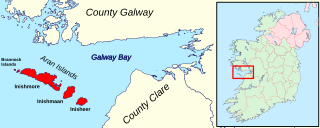
The Aran Islands or The Arans are a group of three islands at the mouth of Galway Bay, off the west coast of Ireland, with a total area around 46 km2 (18 sq mi). They constitute the historic barony of Aran in County Galway.
The Druid Theatre Company, referred to as Druid, is an Irish theatre company, based in Galway, Ireland.
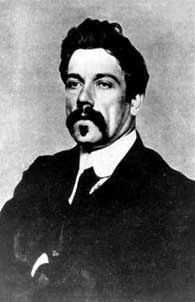
Edmund John Millington Synge was an Irish playwright, poet, writer, collector of folklore, and a key figure in the Irish Literary Revival. His best-known play The Playboy of the Western World was poorly received, due to its bleak ending, depiction of Irish peasants, and idealisation of patricide, leading to hostile audience reactions and riots in Dublin during its opening run at the Abbey Theatre, which he had co-founded with W. B. Yeats and Lady Gregory. His other major works include In the Shadow of the Glen (1903), Riders to the Sea (1904), The Well of the Saints (1905), and The Tinker's Wedding (1909).

Saint Brigid of Kildare or Saint Brigid of Ireland is the patroness saint of Ireland, and one of its three national saints along with Patrick and Columba. According to medieval Irish hagiographies, she was an abbess who founded the important abbey of Kildare, as well as several other monasteries of nuns. There are few documented historical facts about her, and her hagiographies are mainly anecdotes and miracle tales, some of which are Christianisations of hero tales from Irish mythology. They say Brigid was the daughter of an Irish clan chief and an enslaved Christian woman, and was fostered in a druid's household before becoming a consecrated virgin. She is patroness of many things, including poetry, learning, healing, protection, blacksmithing, livestock and dairy production. In her honour, a perpetual fire was kept burning at Kildare for centuries.

Martín de Porres Velázquez was a Peruvian lay brother of the Dominican Order who was beatified in 1837 by Pope Gregory XVI and canonized in 1962 by Pope John XXIII. He is the patron saint of mixed-race people, barbers, innkeepers, public health workers, all those seeking racial harmony, and animals.
Jim Norton is an Irish stage, film and television character actor, known for his work in the theatre, most notably in Conor McPherson's The Seafarer, and on television as Bishop Brennan in the sitcom Father Ted.
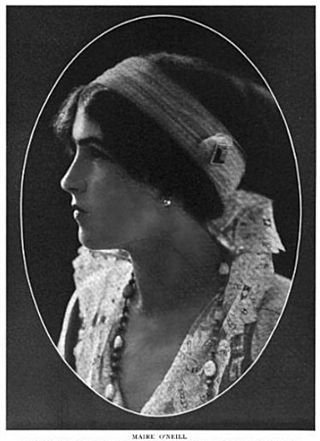
Maire O'Neill was an Irish actress of stage and film. She holds a place in theatre history as the first actress to interpret the lead character of Pegeen Mike Flaherty in John Millington Synge's controversial masterpiece The Playboy of the Western World (1907).
The Playboy of the Western World is a three-act play written by Irish playwright John Millington Synge, first performed at the Abbey Theatre, Dublin, on 26 January 1907. It is set in Michael James Flaherty's public house in County Mayo during the early 1900s. It tells the story of Christy Mahon, a young man running away from his farm, claiming he killed his father.

The Emerald Isle; or, The Caves of Carrig-Cleena, is a two-act comic opera, with music by Arthur Sullivan and Edward German, and a libretto by Basil Hood. The plot concerns the efforts of an Irish patriot to resist the oppressive "re-education" programme of the English, which has robbed the Irish of their cultural heritage. A quirky "Professor of Elocution" who is hired by the English to continue this "re-education" of the Irish switches sides to help the Irish defend their culture. Romantic complications cause a confrontation between the Irish patriots and the superstitious English at the supposedly haunted caves of Carric-Cleena, and disguises are employed to hold the English off; but the professor ultimately comes up with a solution that works out happily for all.

Riders to the Sea is a play written by Irish Literary Renaissance playwright John Millington Synge. It was first performed on 25 February 1904 at the Molesworth Hall, Dublin, by the Irish National Theater Society with Helen Laird playing Maurya. An one-act tragedy, the play is set at Inishmaan in the Aran Islands, and like all of Synge's plays it is noted for capturing the poetic dialogue of rural Ireland. The plot is based not on the traditional conflict of human wills but on the hopeless struggle of a people against the impersonal but relentless cruelty of the sea.
The Tinker's Wedding is a two-act play by the Irish playwright J. M. Synge, whose main characters—as the title suggests—are Irish Tinkers. It is set on a roadside near a chapel in rural Ireland and premiered on 11 November 1909.
Deirdre of the Sorrows is a three-act play written by Irish playwright John Millington Synge in 1909. The play, based on Irish mythology, in particular the myths concerning Deirdre, Naoise, and Conchobar, was unfinished at the author's death on 24 March 1909. It was completed by W. B. Yeats and Synge's fiancée, Molly Allgood and first performed at the Abbey Theatre by the Irish National Theatre Society on 13 January 1910, with Allgood as Deirdre.

Each of the three Synoptic Gospels tells of Jesus healing the blind near Jericho, as he passed through that town, shortly before his passion.

Sarah Ellen Allgood, known as Sara Allgood, was an Irish-American actress. She first studied drama with the Irish nationalist Daughters of Ireland and was at the opening of the Irish National Theatre Society.

Simeon the Holy Fool was a Christian monk, hermit and saint of Byzantine-Syrian origin, who lived in the sixth century AD. He is venerated by the Eastern Orthodox Church and Roman Catholic Church as one of the first "fools for Christ". It is claimed that he simulated madness in order not to be venerated for his social deeds, dragging a dead dog around, throwing nuts at women, and generally acting like an imbecile.

The miracle of healing the man born blind is one of the miracles of Jesus in the Gospels, in which Jesus restored the sight of a man at Siloam. Although not named in the gospel, church tradition has ascribed the name Celidonius to the man who was healed. The account is recorded in the ninth chapter of the Gospel of John.
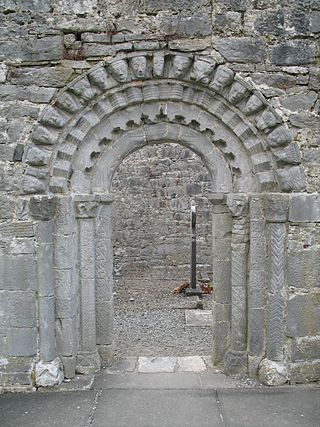
Dysart and Ruan is a Catholic parish in County Clare, Ireland. It covers the civil parishes of Ruan and Dysert, and includes the village of Ruan, which holds the parish office. The parish contains the ruins of the 12th century St. Tola's Church, part of Dysert O'Dea Monastery.
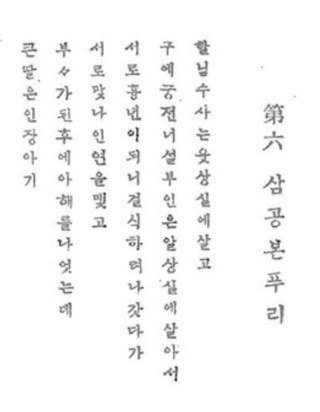
The Samgong bon-puri (Korean: 삼공본풀이) is a Korean shamanic narrative recited in southern Jeju Island, associated with the goddess Samgong. It is among the most important of the twelve general bon-puri, which are the narratives known by all Jeju shamans.
References
- Synge, J. M. The Complete Plays. 1st. New York: Vintage Books, 1935.